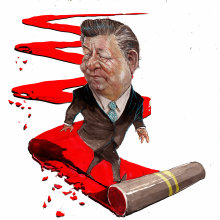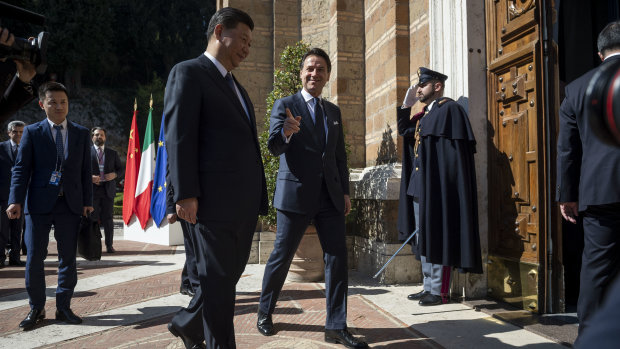Why Victoria took a wrong turn on China's Belt and Road
Victoria has little to show for signing up to China's Belt and Road Initiative and keeping the MOU sends the wrong signal.
China is learning that international understanding is not a commodity that can be stockpiled. Since the Belt and Road Initiative was announced in 2013, Chinese officials have raced to sign memorandums of understanding (MOUs). But the Australian state of Victoria, which signed up in 2018, has little to show for endorsing Chinese President Xi Jinping’s signature foreign policy vision. The document is devoid of economic value and keeping it would send the wrong political signal.
The Belt and Road is the best known, least understood global vision in recent history. It is many things to many people, and full of symbolism, much of it misleading. Using images of camel caravans and quoting Marco Polo, Chinese officials have cast it as a peaceful effort to revive the ancient silk routes. More concrete symbols are the massive projects – railways, deep-sea ports and coal-fired power plants – that Chinese state-owned enterprises are building around the world.

But it is actually the MOU that best captures what the Belt and Road is – and isn’t. China has inked MOUs and co-operation agreements with more than 130 countries. At regional gatherings and grand celebrations in Beijing, Chinese officials advertise the Belt and Road as multilateral. But like its mountain of MOUs, the Belt and Road is actually a sea of bilateral agreements, in which China remains the stronger party and captures more of the immediate benefits.
During its early years, the Belt and Road was practically religion for Chinese officials, who fanned out across the globe to proselytise wherever an audience could be found, even if that meant reaching beneath national authorities.
Before Victoria’s officials took the plunge, in 2016, Canada’s province of British Columbia signed an MOU with Guangdong, a Chinese province. In 2017, Chinese state media mischievously speculated that California could join when then-governor Jerry Brown visited Beijing for climate talks. (It hasn’t.)
China’s emphasis on quantity over quality is vividly illustrated in the MOUs. For all the fanfare from supporters, and anxiety from critics, the documents are weak. They use vague aspirational language about “promoting the silk road spirit” and “the building of a common future.”
Plenty of these documents have not been made public, just like financial details around many Chinese projects. But those that have been shared are thin and shallow compared with trade agreements. Many come with disclaimers noting they are not legally binding.
Buying into China's narratives
The Belt and Road’s yawning gap between promises and benefits is also apparent. Even as China has announced fewer deals in recent years, it has continued to sign up more countries, a recipe for disappointment. Winning support among advanced economies has been a top priority. Yet members of the European Union who have signed Belt and Road MOUs have seen their exports to China grow slower than members who have not signed up.

Italy now regrets signing up. It literally rolled out the red carpet for Xi’s visit to Rome last year. Afterwards, Xi continued on to France, which did not sign an MOU, but announced $45 billion in deals, 16 times more than Italy had done. Inadvertently, the trip signalled how little value these MOUs carry. “The MOU on the silk routes with China was a mistake. Xi’s China is no longer what it used to be,” Vincenzo Amendola, Italy’s Foreign Minister for European affairs, admitted last month.
Given how little commercial value Belt and Road MOUs carry, it is worth asking what political purpose they serve. For Chinese officials, the documents show they are advancing their leader’s vision. They are also part of China’s economic statecraft, which uses carrots to convince countries to align with Beijing’s political objectives, and as Australia is experiencing, coercion when they do not fall in line. Signing them adds legitimacy to official Chinese narratives.
Lending that credibility is inappropriate, especially given that China has not upheld even the first sentence of its MOU with Victoria. It calls for “inclusiveness”, but China imprisons more than a million ethnic and religious minorities and detains journalists and foreign NGO workers. It calls for “peace", but China militarises disputed territory. It calls for “openness”, but China lashes out against calls for an international inquiry into the COVID-19 pandemic.
But ending the MOU should not distract from the bigger challenge. Because the document never accomplished much, nor will its absence. Rather than endorsing the Belt and Road, or condemning every project with Chinese involvement, countries must examine economic opportunities on their merits and with the broader goal of building resilience to coercion. Co-operation partners and allies are key, and inadvertently, China is deepening mutual understanding – among its competitors.
Jonathan E. Hillman is author of The Emperor’s New Road: China and the Project of the Century and director of the Reconnecting Asia Project at the Centre for Strategic and International Studies in Washington DC
No comments:
Post a Comment